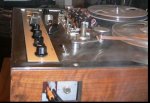jpmorris
Tape Wolf
On the subject of the capstan drive, I am curious about something.
On most of my machines, including a Studer A807 and Otari MX80, the pinch roller presses against the backing, with the oxide surface pressing against the capstan. However, on the MSR-24, the oxide presses into the pinch roller, with the capstan shaft pressing against the backing.
Is there an advantage to either configuration?
On most of my machines, including a Studer A807 and Otari MX80, the pinch roller presses against the backing, with the oxide surface pressing against the capstan. However, on the MSR-24, the oxide presses into the pinch roller, with the capstan shaft pressing against the backing.
Is there an advantage to either configuration?




